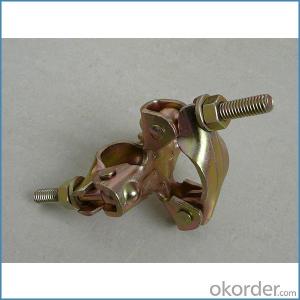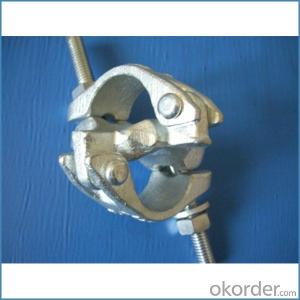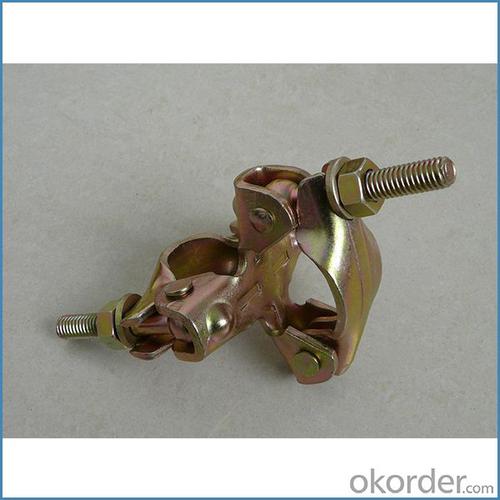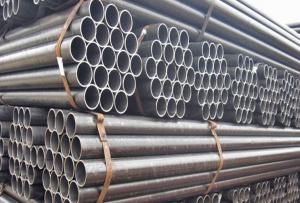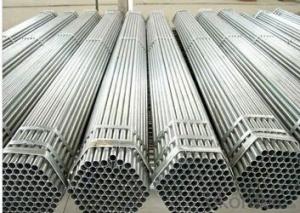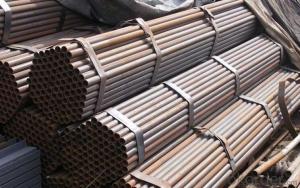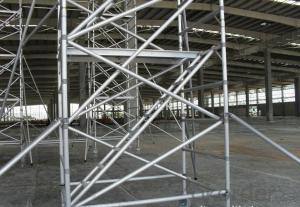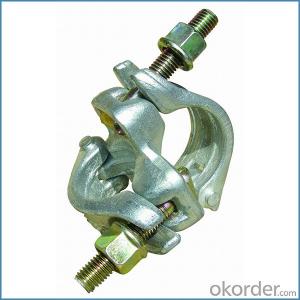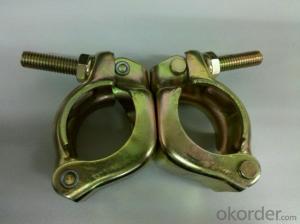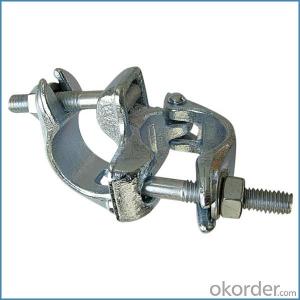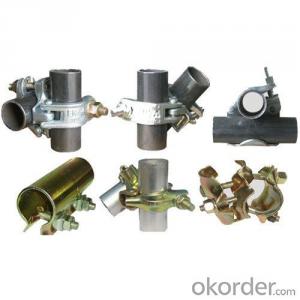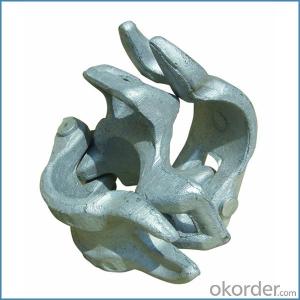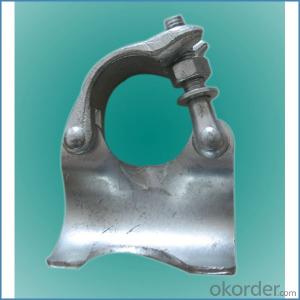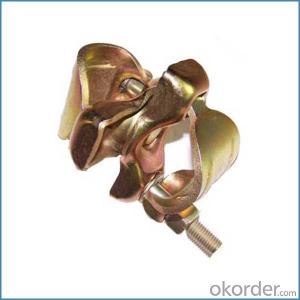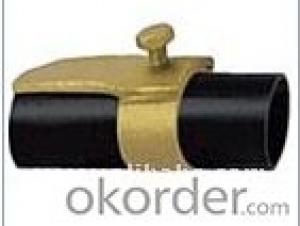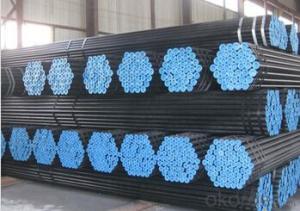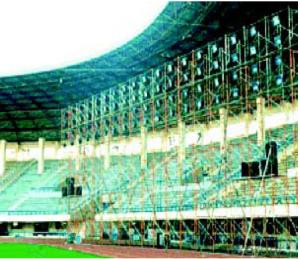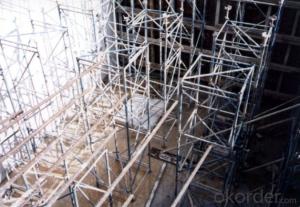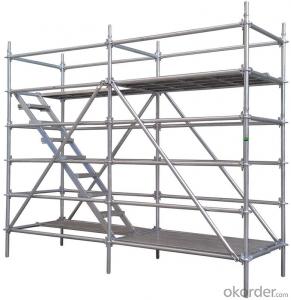Scaffolding Spring Clamp british German Forged Type
- Loading Port:
- Tianjin
- Payment Terms:
- TT OR LC
- Min Order Qty:
- 1000 kg
- Supply Capability:
- 100000 kg/month
OKorder Service Pledge
OKorder Financial Service
You Might Also Like
Scaffolding Spring Clamp british German Forged Type
Description
1.The scaffolding coupler is always used to connect the steel pipe as scaffolding system.
2.The often used coupler is swivel coupler and righ angle coupler .
3.We can provide types of scaffolding coupler according to your requirement.
4.Couoler can fix the 48.3mm scaffolding steel pipe tightly and make the whole scaffolding system more steadily.
Feature
(1)Excellent Anti-Breaking—Cold Pressed Steel
(2)Outstanding Resistance Deformation
(3)Strong Anti-Dropping Ability
Photo
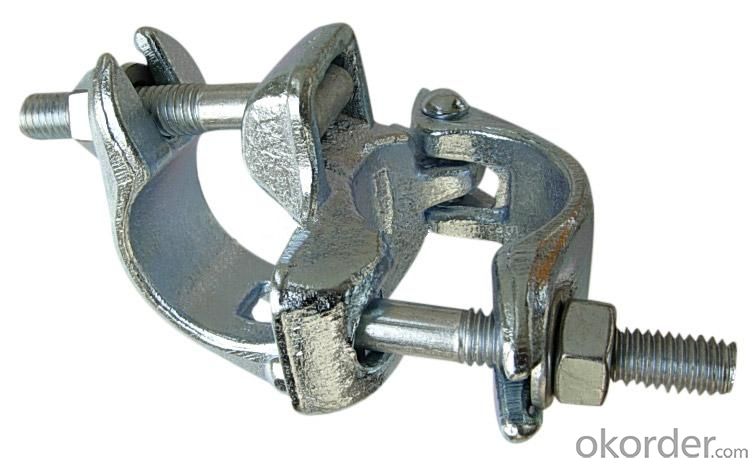
Parameter
| Material | Q235,345steel |
| Size | 48.3mm*48.3mm |
| Surface finish | Galvanized |
| Weight | 1.1kg around |
| Standard | BS1139,EN74 |
| Package | 25pcs/bag,steel pallet |
| Manufacture | As per customer requirement |
| Market | Africa, South America, the Middle East and Asia |
FAQ
Q: Are you a factory or trading company?
We are a state-owned corporation in China,dealing with various kinds of building materials.We have our holding subsidiaries.
Q: Where is your factory located? How can I visit there?
Our factory is located all around China.
Q: Can I get some samples?
Sample is free, customer only pay freight for the first time.
Q: Delivery?
10-30days. (5-15 containers)
Any question,feel free to contact us.
- Q: How do steel tube couplers attach to scaffolding tubes?
- Steel tube couplers attach to scaffolding tubes by being slid over the end of the tube and secured in place using a tightening mechanism. The coupler typically consists of two parts - a sleeve and a wedge. The sleeve is a hollow cylindrical metal component that fits snugly over the end of the tube, while the wedge is a wedge-shaped piece that is inserted into the sleeve. To attach the coupler, the sleeve is first placed onto the tube, ensuring that it is positioned correctly and aligned with the desired angle. The wedge is then inserted into the sleeve, with the angled side facing towards the tube. As the wedge is pushed into the sleeve, it creates a tight grip on the tube, effectively locking the coupler in place. Once the coupler is attached, it provides a secure connection between two scaffolding tubes, allowing them to be joined together to form the desired structure. The tight grip of the coupler ensures stability and strength, enabling the scaffolding to support the weight of workers and materials safely. It is important to note that the installation of steel tube couplers should be carried out by trained and experienced scaffolders, who have a thorough understanding of the correct procedures and safety regulations. Proper installation and regular inspections are essential to ensure the integrity of the scaffolding structure and prevent any accidents or failures.
- Q: Can steel tube couplers be used in scaffolding projects with limited access to lifting equipment?
- Yes, steel tube couplers can be used in scaffolding projects with limited access to lifting equipment. Steel tube couplers are designed to securely connect scaffolding tubes without the need for welding or additional lifting equipment. They provide a strong and reliable connection, making them suitable for scaffolding projects in areas where lifting equipment may not be readily available or accessible.
- Q: Roof 1 meter five of the building how to set up a template
- Xianxian North Road, building materials factory very good, you can find the Google search
- Q: Can steel tube couplers be used for scaffolding structures that need to support heavy loads at different heights?
- Yes, steel tube couplers can be used for scaffolding structures that need to support heavy loads at different heights. Steel tube couplers are specifically designed to provide a secure and reliable connection between scaffolding tubes, ensuring stability and strength. They are capable of withstanding the weight and pressure exerted by heavy loads, making them suitable for scaffolding structures that require support at varying heights.
- Q: How do steel tube couplers affect the overall adaptability and versatility of scaffolding designs?
- Steel tube couplers play a crucial role in enhancing the overall adaptability and versatility of scaffolding designs. These couplers are used to connect steel tubes together, forming a stable and secure structure that can be easily adjusted and modified as needed. One of the key ways in which steel tube couplers contribute to adaptability is through their ability to connect tubes at various angles. With the use of different types of couplers such as swivel couplers and right-angle couplers, scaffolding structures can be easily constructed to fit into irregular or confined spaces. This flexibility allows scaffolding to be adapted to different project requirements, making it suitable for a wide range of construction and maintenance tasks. Moreover, steel tube couplers provide versatility by enabling quick and easy assembly and disassembly of scaffolding systems. The couplers are designed to be tightened securely, ensuring the stability of the structure while also allowing for efficient adjustments or modifications. This versatility is particularly beneficial in projects with changing requirements or tight timelines, as scaffolding can be easily reconfigured or extended without the need for significant time or effort. Another important aspect of steel tube couplers is their compatibility with different scaffolding components. These couplers can be used to connect steel tubes of various sizes and lengths, as well as other scaffolding elements such as boards, platforms, and braces. This compatibility enables the construction of scaffolding systems that can support different loads and heights, catering to the specific needs of each project. In summary, steel tube couplers greatly enhance the overall adaptability and versatility of scaffolding designs. Their ability to connect tubes at different angles, facilitate quick assembly and disassembly, and compatibility with various scaffolding components make them indispensable in creating versatile and adaptable scaffolding structures.
- Q: How do steel tube couplers affect the overall noise level of a scaffolding structure during use?
- Steel tube couplers do not have a direct impact on the noise level of a scaffolding structure during use. The noise level is primarily influenced by the activities taking place on the scaffolding, such as workers' movements, equipment usage, and the materials being handled.
- Q: What are the common sizes of steel tube couplers?
- Steel tube couplers come in various sizes depending on the specific application and industry. While there are standard sizes widely used, the diameters of these couplers can vary. Typically, steel tube couplers are available in diameters ranging from 1/2 inch (12.7 mm) to 4 inches (101.6 mm) or more. These sizes are commonly utilized in plumbing, construction, and industrial settings. For instance, in plumbing and irrigation systems, you can find steel tube couplers in sizes like 1/2 inch, 3/4 inch, 1 inch, and 1 1/4 inch. These smaller sizes are suitable for connecting pipes and tubes in residential and commercial plumbing installations. In construction and structural applications, larger steel tube couplers are commonly used. Sizes such as 2 inches, 3 inches, and 4 inches are frequently employed to connect steel pipes or tubes in building frames, scaffolding, or other structural support systems. It's important to note that these sizes are not exhaustive, and there may be additional options available depending on the manufacturer or specific project requirements. When selecting the appropriate size of steel tube couplers for a particular application, it is always recommended to consult the relevant standards or specifications.
- Q: What safety measures should be taken when working with steel tube couplers in scaffolding?
- To ensure the safety of workers and prevent accidents when working with steel tube couplers in scaffolding, it is crucial to implement several safety measures. Consider the following key precautions: 1. Training and Competency: Workers must undergo comprehensive training and demonstrate their competence in working with steel tube couplers. This includes understanding their correct usage, installation techniques, and potential hazards associated with scaffolding. 2. Inspection and Maintenance: Regularly inspecting steel tube couplers is essential to identify any signs of wear, damage, or corrosion. Any damaged or faulty couplers should be promptly replaced to maintain the overall structural integrity of the scaffolding. 3. Load Capacity: It is vital to comprehend the load capacity of both the steel tube couplers and the scaffolding system in use. Overloading can result in collapse or failure, leading to severe injuries or fatalities. Always adhere to the manufacturer's guidelines and consult a structural engineer if necessary. 4. Secure Connections: Properly securing the connections of steel tube couplers is crucial for maintaining stability. Ensure that the couplers are tightly fastened and that there is no movement or looseness in the connections. Loose or improperly secured couplers can cause accidents or make the scaffold unstable. 5. Fall Protection: Workers should be equipped with appropriate fall protection equipment, such as harnesses and lanyards, when working at heights. Additionally, install guardrails and toe boards on scaffolding platforms to prevent falls and ensure a safe working environment. 6. Stability and Base Support: Erect scaffolding on a stable and level surface. Properly position and secure the base plates or adjustable jacks to prevent any movement or instability during use. 7. Communication and Signage: Clear communication among workers is crucial to avoid accidents. Use proper signage, such as warning signs and barricades, to mark areas where scaffolding is in use and to inform others to keep a safe distance. 8. Weather Conditions: Take into account the impact of weather conditions on scaffolding stability. Strong winds, rain, or snow can significantly affect the safety and stability of the scaffolding. Regularly check weather forecasts and take appropriate measures to protect against adverse conditions. 9. Personal Protective Equipment (PPE): Workers must be provided with and wear suitable PPE, such as hard hats, safety glasses, gloves, and appropriate footwear, to protect against potential hazards associated with steel tube couplers. By adhering to these safety measures, workers can minimize the risk of accidents, ensure the structural integrity of scaffolding, and create a safe working environment when using steel tube couplers.
- Q: How do you ensure proper alignment when connecting steel tube couplers in temporary scaffolding?
- To ensure proper alignment when connecting steel tube couplers in temporary scaffolding, there are several key steps to follow: 1. Start by inspecting the tubes and couplers to ensure they are free from any damage or defects. Any damaged or faulty components should be replaced before proceeding. 2. Before connecting the couplers, clean the tube ends to remove any dirt, debris, or rust that could hinder the proper alignment. This can be done using a wire brush or sandpaper. 3. Align the tube ends properly by ensuring they are straight and parallel to each other. This can be achieved by using a spirit level or a straightedge to check for any misalignment. 4. Apply a lubricant or grease to the tube ends to facilitate a smooth connection. This will make it easier to slide the couplers onto the tubes and ensure a proper fit. 5. When connecting the couplers, make sure they are fully engaged with the tube ends. This can be done by applying sufficient force or using a hammer to gently tap the coupler onto the tube until it is secure. 6. Once the couplers are connected, check the alignment again to ensure that the tubes are still straight and parallel. Use a spirit level or straightedge to verify the alignment. 7. If any misalignment is detected, make the necessary adjustments by loosening the couplers and repositioning the tubes. Repeat the alignment and connection process until proper alignment is achieved. 8. Finally, tighten the couplers securely using an appropriate tool, such as a scaffold wrench, to ensure a strong and stable connection. This will help prevent any movement or dislodgment of the tubes during use. By following these steps, you can ensure proper alignment when connecting steel tube couplers in temporary scaffolding, which is crucial for the safety and stability of the structure.
- Q: How do steel tube couplers ensure a secure connection between tubes?
- The design and mechanical properties of steel tube couplers guarantee a secure connection between tubes. Firstly, these couplers are engineered to achieve a precise fit between two tubes, minimizing any potential movement or play between them. This precise fit plays a crucial role in maintaining the structural integrity of the connection. Moreover, steel tube couplers commonly incorporate internal teeth or grooves that firmly grip onto the surface of the tubes. These teeth generate a strong frictional force that effectively prevents any sliding or rotation between the tubes. This gripping action significantly enhances the stability and security of the connection, especially in scenarios where the tubes are subjected to axial or torsional loads. In addition to the gripping mechanism, steel tube couplers are typically manufactured using high-strength steel materials. This material choice ensures that the couplers themselves can withstand substantial forces and stresses without experiencing any deformation or failure. By utilizing strong and durable materials, the couplers establish a reliable and robust connection between the tubes, even under demanding conditions. Overall, steel tube couplers guarantee a secure connection between tubes by providing a precise fit, employing a gripping mechanism, and utilizing high-strength materials. These features synergistically create a connection that is resistant to movement, rotation, and failure, instilling confidence in the structural integrity of the joined tubes.
Send your message to us
Scaffolding Spring Clamp british German Forged Type
- Loading Port:
- Tianjin
- Payment Terms:
- TT OR LC
- Min Order Qty:
- 1000 kg
- Supply Capability:
- 100000 kg/month
OKorder Service Pledge
OKorder Financial Service
Similar products
Hot products
Hot Searches
Related keywords
